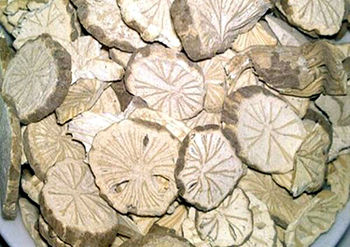Stephania Tetrandra
Other Names : Han Fang Ji, 漢防己; pinyin: hàn fáng jǐ, Radix Stephaniae Tetrandrae, Stephania Root, Shen Nong Ben Cao Jing
Special Precautions of Stephania Tetrandra
- Being bitter and cold, it can easily damage stomach qi, so it should be used cautiously to treat patients with anorexia and weak constitution due to yin deficiency.
- Its bitter, cold nature readily injures the Stomach.
- Use caution for those with Spleen and Stomach Deficiencies.
- Use caution for those with Yin Deficiency.
- Contraindicated for those with Blood Deficiency before or after parturition.
- Concurrent use with diuretics such as chlorothiazide, hydrochlorothiazide, furmoside (Lasix), bumetinide (Bumex) and torsemide (Demadex) may lead to increased elimination of water and/or electrolytes.
- Guang Fang Ji preparations can contain toxic amounts of aristolochic acid when Aristolchia fanghi is substituted for Stephania tetrandra. Ingestion can lead to renal failure and even death; Aristolochia is used in TCM only with great caution. In May, 2000, the FDA began detaining any plants or medicines suspected of containing aristolochic acid, unless laboratory testing indicated they were negative for aristolochic acid. (Only tests which use a liquid chromatography/tandem mass spectrometry [LC/MS/MS] method with a precision better than 0.5 parts per million (PPM) are acceptable.) he traditional route of ingestion of guang fang ji is via water decoction. Since aristolochic acid has low water solubility, water decoction is believed to be a much safer route than taking guang fang ji as an uncooked powder.
- Guang Fang Ji preparations can contain toxic amounts of aristolochic acid when Aristolchia fanghi is substituted for Stephania tetrandra. Ingestion can lead to renal failure and even death; Aristolochia is used in TCM only with great caution. In May, 2000, the FDA began detaining any plants or medicines suspected of containing aristolochic acid, unless laboratory testing indicated they were negative for aristolochic acid. (Only tests which use a liquid chromatography/tandem mass spectrometry [LC/MS/MS] method with a precision better than 0.5 parts per million (PPM) are acceptable.)The traditional route of ingestion of guang fang ji is via water decoction. Since aristolochic acid has low water solubility, water decoction is believed to be a much safer route than taking guang fang ji as an uncooked powder.
Benefits and uses of Stephania Tetrandra are
Stephania root has anti-inflammatory, anti-tumor, antibacterial, and diuretic properties. It is used to manage water retention and edema, eliminate stagnant bronchial mucous, detoxify the body, promote urination, and expel heat in painful joints. Stephania root is used to treat abdominal distension, inflammation, fever, and pain. It is traditionally used to dispel wind and dampness to relieve pain and to promote diuresis. It is classified as acrid, bitter and cold. The part used is the root. Stephania contains tetrandrine, a potent smooth muscle relaxant under preliminary in vitro studies related to cardiovascular effects and some forms of cancer.
- Promotes urination and reduces edema especially in the lower body : Edema due to Dampness accumulating in the Lower Jiao with damp leg Qi, borborygmus, abdominal distention, ascites
- Expels Wind-Dampness and alleviates pain (purges Damp-Heat) : Wind-Damp-Heat collecting in the channels with fever, red, hot, swollen, painful joints (Wind-Damp-Heat Bi)
- Painful contractions of the hands and feet (antirheumatic)
- Ebola : Tetrandrine, which is derived from the Stephania tetrandra has been found blocking the virus from interacting with cells, thus preventing it from taking hold and infecting the body.
